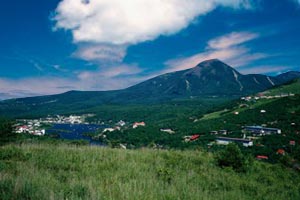Mount Abu
Mount Abu - a pleasant retreat and green oasis in Rajasthan in western India is the only hill station in the desert scape of Rajasthan. Set amidst the lush forested hills at the southern tip of the Aravalli range, the hill station has a cool climate because of rich flora that covers the hills.
Situated at a height of 1220 meters above sea level, the 22 km long hill station has many tourist attractions like the famous Dilwara temples carved in white marble, Nakki Lake and a big bird sanctuary.
Huge rocks in weird shapes dot the undulating road that leads to Mount Abu. Besides being a summer retreat, Mount Abut boasts of the exquisite Dilwara Jain temples that date back to 11th-13th centuries, Hindu temples and many places of tourist interest.
Mount Abu derived its name from a legendary character Arbuda, the son of Himalayas, a powerful serpent which rescued Nandi, the sacred bull of Lord Shiva from a chasm. Originally it was Mount Arbud and Abu is a diminutive of this name.
MOUNT ABU TRAVEL
The nearest airport to Mount Abu is Udaipur. Flights from Mumbai, Delhi and Jaipur operate everyday to Udaipur. Mount Abu is well connected by rail to many cities like Ahmedabad, Mumbai, Jaipur and Jodhpur and the nearest railway station is Abu Road, which is about 22 kms from it. You can travel by comfortable deluxe buses run by the Rajasthan roadways from Abu Road or from Jaipur to Mount Abu. Delhi, Udaipur, Ajmer and Udaipur are also well connected by road to Mount Abu.
Mount Abu Tourism
Dilwara Temples
These temples elegantly built in white marble have beautiful carvings and were built between the 11th and 13th centuries AD. Dedicated to the Jain Thirthankaras, they all lie within a small area of 5 sq. km. These temples are rated as among the finest of Indian temples. You can compare the marble architecture of these temples with the best in the world.
The oldest of these, The Vimal Vasahi temple, dedicated to the first Thirthankara was built in 1031 AD. In the central shrine you can see the image of Rishabhdev and a very big courtyard with 52 small shrines. Each of these shrines houses an exquisitely carved statue of a Thirthankara. The entrance to this courtyard is formed with 48 elegantly carved pillars.
Another temple which is a fine specimen of craftsmanship is the Lun Vasahi temple dedicated to the 22nd Thirthankara, Neminath. This was built in 1231 AD by two brothers, Vastupal and Tejpal who were the Ministers of Raja Vir Dhawal, a ruler of Gujarat. The door casings, pillars, architraves and the sculptures on porticos are real masterpieces.
Gaumukh Temple
You can see a natural spring that flows through a sculpted cow's head at this temple. The temple received its name from this sculpture. Against the beautiful backdrop stands an exquisitely sculpted hill temple of Arbuda, a mighty serpent who saved Nandi, the sacred bull of Lord Shiva. The marble image of Nandi is located nearby.
Adhar Devi temple is another tourist attraction. Chiseled out of a huge rock, the temple can be reached by a flight of 360 steps.
Sunset Point is a place from where you can watch the setting sun. The hills are covered with a golden glow during sunset.
Honeymoon Point, a beautiful place offers a good view of the verdant plains and valleys. It is also known as Andra Point and the enchanting view of the plains should be viewed during dusk.
Nakki Lake:
This is a lake in Mount Abu, where you can hire boats at reasonable rates. It is a belief that gods gouged this lake out of the earth by their fingernails and hence the name (nakk in Hindi means finger).
Shri Raghunathji Temple
A temple dedicated to Shri Raghunathji is found near the Nakki Lake. A beautiful image of the deity placed in the 14th century AD by Shri Ramanand, a famous Hindu preacher adorns this temple.
Another world famous religious community center here is the headquarters of the Brahmkumari Ashram. The World Spiritual University of the same order is also located here.
Ashok Vatika, Gandhi Park, Municipal park, Shaitan Singh Park and Terrace Garden are some of the famous gardens that are beautifully laid and interspersed throughout Mount Abu.
Trevor's Tank Bird watchers would love to visit this tank, named after a British engineer who constructed it. Pigeons, peacocks and partridges are a delight to watch at the densely wooded hills.
Achalgarh Fort: This impressive fort built in 14th century is about five miles from Mount Abu, with the notable Achaleswar Mahadev temple dedicated to Lord Shiva. The warrior king Rana Kumbha built this fort along with other 31 forts all over Mewar, to protect the kingdom from invaders. The Kanthinath Jain Temple has a gold-plated image. Most of this fort is ruined now. You can see the remains of many ancient temples around here. This fort is easily approachable by car.
Guru Shikar: The highest point in Rajasthan, Guru Shikar is at an altitude of 5,676 feet and is around two miles further to Achalgarh. You can have a bird's eye view of Mount Abu from this peak. Mira Temple, Chamundi Temple, Dattatreya Temple and a tiny Shiva temple are noteworthy here.
You can enjoy the flora and fauna around here. The highest point of the Aravalli renges, Gurushikar has a big wild life sanctuary which was established in 1960. It is a haven for a number of species such as leopards, langur, Sambar and wild boars. A number of flowering trees enhance the beauty of the scenario.
Mount Abu Weather
Mount Abu has a pleasant weather that suits the traveler. In summer, the maximum temperature is around 33ºC and the minimum is around 23ºC. Ins winter the temperature ranges from 0ºC to 20ºC. Best time to visit Mount Abu is from February to June. September and December also are some suitable months for a visit.
|































